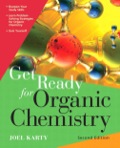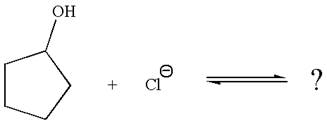
(a)
Interpretation:
The products for the given proton transfer reaction are to be drawn and the favored equilibrium side with numerical factor is to be determined.
Concept introduction:
The proton transfer reactions favor the side opposite the stronger acid. Larger the
Answer to Problem 6.41P
The products for the given reaction are:

The equilibrium is favored to product side by a factor of
Explanation of Solution
The given reaction is:

The ion

In the conjugate base formed, the negative charge on nitrogen is delocalized through the electron withdrawing resonance effect of carbonyl group. Thus, amide is a stronger acid than water, and hence, the equilibrium is favored to the product side.
The
The favored equilibrium side with numerical value is determined on the basis of stronger acid and
(b)
Interpretation:
The products for the given proton transfer reaction are to be drawn and the favored equilibrium side with the numerical factor is to be determined.
Concept introduction:
The proton transfer reactions favor the side opposite the stronger acid. Larger the
Answer to Problem 6.41P
The products for the given reaction are:

The equilibrium is favored to the reactant side by a factor of
Explanation of Solution
The given reaction is:

In the given reaction,

The favored equilibrium side with numerical value is determined on the basis of the stronger acid and
(c)
Interpretation:
The products for the given proton transfer reaction are to be drawn and the favored equilibrium side with numerical factor is to be determined.
Concept introduction:
The proton transfer reactions favor the side opposite the stronger acid. Larger the
Answer to Problem 6.41P
The products for the given reaction are:

The equilibrium is favored to product side by a factor of
Explanation of Solution
The given reaction is:

In the given reaction, cyclopentadiene acts as an acid and the negatively charge nitrogen abstracts a proton from diisopropylamine to give the following products:

On the product side, the negative charge on carbon is a resonance stabilized by a conjugated double bond; such stabilization of the negative charge is not possible on the reactant side where the negative charge is on nitrogen bonded to two electron donating isopropyl groups. The acid is stronger when its conjugate base is stable, therefore, cyclopentadiene is a stronger acid than
According to Appendix
The favored equilibrium side with numerical value is determined on the basis of stronger acid and
(d)
Interpretation:
The products for the given proton transfer reaction are to be drawn and the favored equilibrium side with numerical factor is to be determined.
Concept introduction:
The proton transfer reactions favor the side opposite the stronger acid. Larger the
Answer to Problem 6.41P
The products for the given reaction are:

The equilibrium is favored to the product side by a factor of
Explanation of Solution
The given reaction is:

In the given reaction, the hydride ion abstracts the terminal proton of an

As the effective electronegativity of
According to Appendix
The favored equilibrium side with numerical value is determined on the basis of stronger acid and
(e)
Interpretation:
The products for the given proton transfer reaction are to be drawn and the favored equilibrium side with numerical factor is to be determined.
Concept introduction:
The proton transfer reactions favor the side opposite the stronger acid. Larger the
Answer to Problem 6.41P
The products for the given reaction are:

The equilibrium is favored to the product side by a factor of
Explanation of Solution
The given reaction is:

In the given reaction, the propanoate ion abstracts the proton of hydronium ion to give the following products:

According to Appendix
The favored equilibrium side with numerical value is determined on the basis of stronger acid and
(f)
Interpretation:
The products for the given proton transfer reaction are to be drawn and the favored equilibrium side with numerical factor is to be determined.
Concept introduction:
The proton transfer reactions favor the side opposite the stronger acid. Larger the
Answer to Problem 6.41P
The products for the given reaction are:

The equilibrium is favored to the product side. Benzene is the weaker acid by a factor of
Explanation of Solution
The given reaction is:

In the given reaction, the

As the oxygen atom is more electronegative than carbon, the negative charge on oxygen is more stable as compared to carbon. Thus, an anion on the right side, having negative charge on oxygen, is more stable than the anion on the left side where the negative charge is on carbon. Therefore, propanol is more acidic than benzene, and hence, the reaction is favored to the product side.
According to Appendix
The favored equilibrium side with numerical value is determined on the basis of stronger acid and the
(g)
Interpretation:
The products for the given proton transfer reaction are to be drawn and the favored equilibrium side with numerical factor is to be determined.
Concept introduction:
The proton transfer reactions favor the side opposite the stronger acid. Larger the
Answer to Problem 6.41P
The products for the given reaction are:

The equilibrium is favored to the product side. Benzene is the weaker acid by a factor of
Explanation of Solution
The given reaction is:

In the given reaction, the hydride ion abstracts the proton from carboxylic acid and gives the following products:

The conjugate base formed with a negative charge on the oxygen atom is better stabilized by the resonance effect. This makes the carboxylic acid the stronger acid, and the equilibrium is favored to the product side.
According to Appendix
The favored equilibrium side with numerical value is determined on the basis of stronger acid and the
Want to see more full solutions like this?
Chapter 6 Solutions
EBK GET READY FOR ORGANIC CHEMISTRY
- 3. Reactions! Fill in the information missing below. Make sure to pay attention to REGIOCHEMISTRY and STEREOCHEMISTRY. Br2 CH3OH + 4. Mechanism! Show the complete arrow pushing mechanism, including all steps and intermediates for the following reactions. To get credit for this, you MUST show how ALL bonds are broken and formed, using arrows to show the movement of electrons. H3O+ HOarrow_forwardPlease provide a synthesis for the Ester using proponoic acid, thank you!arrow_forwardPlease help with the curved arrow mechanism of this reaction, thank youarrow_forward
- Concentration (mg/l) Peak Area 0 158 10 10241 20 18425 30 26457 40 37125 50 44256 60 56124 Question: Determine the regression equation (a and b coefficients) from first principlesarrow_forwardConcentration (mg/l) Peak Area 0 158 10 10241 20 18425 30 26457 40 37125 50 44256 60 56124 You have been asked to determine the concentration of citral in a highly valued magnolia essential oil. QUESTION: Calculate the concentration of citral in your highly valued magnolia essential oil which returns a peak area of 41658arrow_forwardNeed help with these problems...if you can please help me understand problems E & F.arrow_forward
- Please help me solve these problems. Thank you in advance.arrow_forwardPredict the products of this organic reaction: O N IN A N + H2O + HCI ? Specifically, in the drawing area below draw the skeletal ("line") structure of the product, or products, of this reaction. If there's more than one product, draw them in any arrangement you like, so long as they aren't touching. If there aren't any products because this reaction won't happen, check the No reaction box under the drawing area. 田 C + Explanation Check Click and drag to start drawing a structure. C © 2025 McGraw Hill LLC. All Rights Reserved. Terms of Use | Privacy Centerarrow_forward6. For each of the following, fill in the synthesis arrows with reagents and show the intermediates. You DO NOT need to use the same number of arrows that are shown (you may use more or less), but the product must be formed from the reactant. Then write the mechanism of one step in the synthesis (you can choose which step to write the mechanism for), including all reagents required, clearly labeling the nucleophile and electrophile for each step, and using curved arrows to show the steps in the mechanism. a. b. OHarrow_forward
- Draw the productsarrow_forwardDraw the correct productsarrow_forwardE Organic Chemistry Maxwell Draw the correct products, in either order, for the ozonolysis reaction: 1) O3, CH2Cl2, -78 °C Product 1 + Product 2 2) Zn, HOAc Draw product 1. Select Draw Templates More C H O presented by M Draw product 2. Erase Select Draw Templates M / # # carrow_forward
 Organic Chemistry: A Guided InquiryChemistryISBN:9780618974122Author:Andrei StraumanisPublisher:Cengage Learning
Organic Chemistry: A Guided InquiryChemistryISBN:9780618974122Author:Andrei StraumanisPublisher:Cengage Learning Organic ChemistryChemistryISBN:9781305580350Author:William H. Brown, Brent L. Iverson, Eric Anslyn, Christopher S. FootePublisher:Cengage Learning
Organic ChemistryChemistryISBN:9781305580350Author:William H. Brown, Brent L. Iverson, Eric Anslyn, Christopher S. FootePublisher:Cengage Learning

